


Weobley Castle (pronounced "weblee "; Welsh : Castell Weble) is a 14th-century fortified manor house on the Gower Peninsula, Wales, in the care of Cadw. The castle overlooks Llanrhidian saltmarshes and the Loughor estuary.



Weobley Castle (pronounced "weblee "; Welsh : Castell Weble) is a 14th-century fortified manor house on the Gower Peninsula, Wales, in the care of Cadw. The castle overlooks Llanrhidian saltmarshes and the Loughor estuary.
The existing buildings were largely created between 1304 and 1327 by the de la Bere family. They consist of a gateway, a hall and kitchen, a chapel block and an east range, enclosing a courtyard, all now in a semi-ruinous state. The buildings are largely constructed of rubble masonry with window and door features of sandstone. [1]
The gateway, at the west of the castle, is framed to its north by the solar block, which contained the lord's private chamber, a latrine and a cellar space. To the south of the gateway is the so-called Cistern Turret, which is believed to have contained a cistern for rainwater storage; behind this is the South-West Tower, which was originally a separate building and may be the oldest part of the present structure. The gateway itself also included an additional living chamber in its upper storey. The northern range of the castle, including the hall, kitchen and porch leading from the inner courtyard, is the most substantial of the surviving sections. Features of the hall include a recess for the display of tapestry or panelling. This supports interpretations of the castle as primarily a wealthy residence rather than a military outpost. During excavations at the Chapel Block, fragments of a piscina were discovered. The eastern range is more fragmentary that other parts, and much of it may never have been developed beyond the foundation stage during the ownership of the de la Beres. [2] Although most of the outer fortifications no longer exist, the remaining portions demonstrate that Weobley was well provided with guestrooms and facilities (including garderobes). The building was extended later in the 14th century, including construction of the south porch. [3]
Until the 15th century the castle was the home of the de la Beres, originally stewards to William De Braose, Lord of Gower. [3] In 1318 the castle is recorded by a deed signed there by Adam de la Bere. [4]
The castle was attacked and damaged by the forces of Owain Glyndŵr in the early 15th century, but most of the building was left standing. [3] It is possible that John de la Bere (d. 1403) was a casualty of Glyndŵr's incursion. [5] Sir Rhys ap Thomas became the owner towards the end of the 15th century; following the execution for treason of Rhys's grandson Rhys ap Gruffydd in 1531, Weobley eventually reverted to the Crown in the person of King Henry VIII. [6] [7] It was then sold and subsequently leased to tenants until the 20th century, when the last owner, Emily Talbot, gave it to the state in 1911. [8]

Harlech Castle in Harlech, Gwynedd, Wales, is a Grade I-listed medieval fortification built onto a rocky knoll close to the Irish Sea. It was built by Edward I during his invasion of Wales between 1282 and 1289 at the relatively modest cost of £8,190. Over the next few centuries, the castle played an important part in several wars, withstanding the siege of Madog ap Llywelyn between 1294–95, but falling to Owain Glyndŵr in 1404. It then became Glyndŵr's residence and military headquarters for the remainder of the uprising until being recaptured by English forces in 1409. During the 15th century Wars of the Roses, Harlech was held by the Lancastrians for seven years, before Yorkist troops forced its surrender in 1468, a siege memorialised in the song "Men of Harlech". Following the outbreak of the English Civil War in 1642, the castle was held by forces loyal to Charles I, holding out until 1647 when it became the last fortification to surrender to the Parliamentary armies. In the 21st century the ruined castle is managed by Cadw, the Welsh Government's historic environment service, as a tourist attraction.

Criccieth Castle is a native Welsh castle situated on the headland between two beaches in Criccieth, Gwynedd, in North Wales, on a rocky peninsula overlooking Tremadog Bay. It was built by Llywelyn the Great of the kingdom of Gwynedd, but was heavily modified following its capture by English forces of Edward I in the late 13th century.

Powis Castle is a medieval castle, fortress and grand country house near Welshpool, in Powys, Wales. The seat of the Herbert family, Earls of Powis, the castle is known for its formal gardens and for its interiors, the former having been described as "the most important", and the latter "the most magnificent", in Wales. The castle and garden are under the care of the National Trust. Powis Castle is a Grade I listed building.
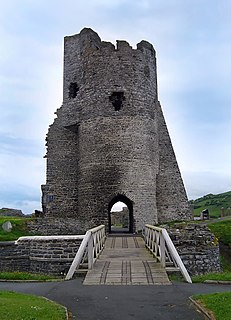
Aberystwyth Castle is a Grade I listed Edwardian fortress located in Aberystwyth, Ceredigion, Mid Wales. It was built in response to the First Welsh War in the late 13th century, replacing an earlier fortress located a mile to the south. During a national uprising by Owain Glyndŵr, the Welsh captured the castle in 1404, but it was recaptured by the English four years later. In 1637 it became a Royal mint by Charles I, and produced silver shillings. The castle was slighted by Oliver Cromwell in 1649.

Swansea Castle is located in the city centre of Swansea, Wales, UK. It was founded by Henry de Beaumont in 1107 as the caput of the lordship of Gower. The castle is now ruined and only two blocks remain, though the site has been improved in the 2010s for use as a public space.

Dolbadarn Castle is a fortification built by the Welsh prince Llywelyn the Great during the early 13th century, at the base of the Llanberis Pass, in northern Wales. The castle was important both militarily and as a symbol of Llywelyn's power and authority. The castle features a large stone keep, which historian Richard Avent considers "the finest surviving example of a Welsh round tower". In 1284 Dolbadarn was taken by Edward I, who removed some of its timbers to build his new castle at Caernarfon. The castle was used as a manor house for some years, before falling into ruin. In the 18th and 19th century it was a popular destination for painters interested in Sublime and Picturesque landscapes. It is now owned by Cadw and managed as a tourist attraction, and is protected as a grade I listed building.

Oxwich Castle is a Grade I listed castle which occupies a position on a wooded headland overlooking Oxwich Bay on the Gower Peninsula, Wales. Although it may occupy the site of an earlier fortification, it is a castle in name only as it is a grand Tudor fortified manor house built in courtyard style.
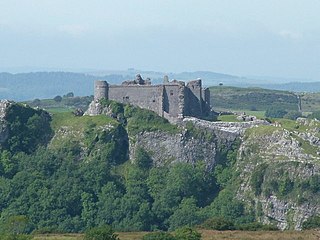
Carreg Cennen Castle is a castle sited on a high rocky outcrop overlooking the River Cennen, close to the village of Trap, four miles south of Llandeilo in Carmarthenshire, Wales. The castle is within the Brecon Beacons National Park, and its location has been described as spectacular, due to its position above a limestone precipice. It has been in a ruinous state since 1462 and is now in the care of Cadw, the Welsh Government historic environment service.

Castell y Bere is a Welsh castle near Llanfihangel-y-pennant in Gwynedd, Wales. Constructed by Llywelyn the Great in the 1220s, the stone castle was intended to maintain his authority over the local people and to defend the south-west part of the princedom of Gwynedd. In 1282, war with Edward I of England resulted in the death of Llywelyn's grandson, Llywelyn ap Gruffudd, and Castell y Bere fell to English forces. Edward I expanded the castle further and established a small town beside it. In 1294 the Welsh leader Madog ap Llywelyn mounted a major revolt and the castle was besieged and apparently burnt. Edward did not repair it and it became ruined. Today it is in the hands of Cadw and operated as a tourist attraction.

Dolforwyn Castle is a Welsh medieval castle above the village of Abermule, Powys. The fortification was established by Llywelyn ap Gruffudd, Prince of Gwynedd in the late 13th century. It is sited on a wooded ridge commanding excellent views of the upper Severn Valley.
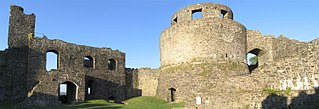
Dinefwr Castle is a ruined castle overlooking the River Tywi near the town of Llandeilo, Carmarthenshire, Wales. It lies on a ridge on the northern bank of the Tywi, with a steep drop of one hundred feet to the river. Dinefwr was the chief seat of the Kingdom of Deheubarth. The castle is a Grade I listed building.

Laugharne Castle is in Laugharne, Carmarthenshire, Wales. The castle, located on the estuary of the River Tâf, was originally established in 1116. It was rebuilt as a Norman stronghold. There have been many alterations since then, including becoming a Tudor fortified manor house in the sixteenth century. It changed hands twice during the English Civil War, being eventually captured by Parliamentary forces in 1644.
John De la Bere was a 15th-century Bishop of St David's in Wales.

Loughor Castle is a ruined, medieval fortification located in the town of Loughor, Wales. The castle was built around 1106 by the Anglo-Norman lord Henry de Beaumont, during the Norman invasion of Wales. The site overlooked the River Loughor and controlled a strategic road and ford running across the Gower Peninsula. The castle was designed as an oval ringwork, probably topped by wicker fence defences, and reused the remains of the former Roman fort of Leucarum.
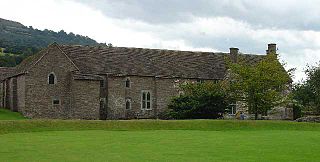
Tretower Court is a medieval fortified manor house in Wales, situated in the village of Tretower, near Crickhowell in modern-day Powys, previously within the historical county of Breconshire or Brecknockshire.
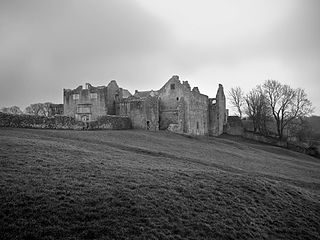
Old Beaupre Castle is a ruined medieval fortified manor house located in the community of Llanfair, outside Cowbridge in Wales. It is known in historic documents under the names Beawpire, Bewerpere, Bewpyr and Y Bewpur. It is a Grade I listed building and is presently under the care of Cadw. It can be visited free of charge all year round by members of the public.
Pen y Clawdd Castle is a ditched mound with a double moat, roughly circular in shape, with a diameter of approximately 28m to 30m and about 2.4m high. The castle is in Llanvihangel Crucorney, about five miles to the north of Abergavenny, Monmouthshire, in south east Wales and lies between the Usk and Monnow rivers. The mound was designated a scheduled monument in 1950 and described as a defensive medieval motte.
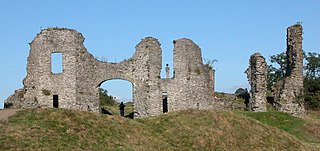
Newcastle Emlyn Castle is a ruined castle in the market town of Newcastle Emlyn in Carmarthenshire, Wales. It is strategically located on a steep-sided promontory overlooking the River Teifi and was probably built by the Welsh lord Maredudd ap Rhys in about 1240. It changed hands many times over the years in battles between the Welsh and English, and during the English Civil War. The remains of the gatehouse and adjacent towers, and some fragments of wall are all that remain visible now.

In the United Kingdom, the term listed building refers to a building or other structure officially designated as being of special architectural, historical, or cultural significance; Grade I structures are those considered to be "buildings of exceptional interest". Listing was begun by a provision in the Town and Country Planning Act 1947. Once listed, strict limitations are imposed on the modifications allowed to a building's structure or fittings. In Wales, the authority for listing under the Planning Act 1990 rests with Cadw.
| Wikimedia Commons has media related to Weobley Castle . |